Effect of Soiling on Solar Photovoltaic Performance under Desert Climatic Conditions
Abstract
1. Introduction
2. Experiment Description and Mathematical Formulation
2.1. System Description
2.2. Experimental Procedure
2.3. Mathematical Model of Relevant Parameters
2.4. System Modelling and Simulation
2.5. Model Validation
3. Results and Discussion
3.1. Weather Data
3.2. Electrical Performance
3.3. Effect of Dust
3.4. Parametric Study
4. Conclusions
Author Contributions
Funding
Institutional Review Board Statement
Informed Consent Statement
Data Availability Statement
Acknowledgments
Conflicts of Interest
References
- Kazem, H.A. Renewable energy in Oman: Status and future prospects. Renew. Sustain. Energy Rev. 2011, 15, 3465–3469. [Google Scholar] [CrossRef]
- Ellabban, O.; Abu-Rub, H.; Blaabjerg, F. Renewable energy resources: Current status, future prospects and their enabling technology. Renew. Sustain. Energy Rev. 2014, 39, 748–764. [Google Scholar] [CrossRef]
- Singh, T.; Hussien, M.A.A.A.; Al-Ansari, T.; Saoud, K.; McKay, G. Critical review of solar thermal resources in GCC and application of nanofluids for development of efficient and cost effective CSP technologies. Renew. Sustain. Energy Rev. 2018, 91, 708–719. [Google Scholar] [CrossRef]
- Alnaser, W.E.; Alnaser, N.W. The status of renewable energy in the GCC countries. Renew. Sustain. Energy Rev. 2011, 15, 3074–3098. [Google Scholar] [CrossRef]
- Mahdi, A.M.J.; Reza, K.S.; Kadhem, J.A.; Al-waeli, A.A.K.; Al-Asadi, K.A.H.; Kadhem, A.H. The Effect of Iraqi Climate Variables on the Performance of Photovoltaic Modules. Int. J. Sci. Eng. Sci. 2017, 1, 7–12. [Google Scholar]
- Charabi, Y.; Gastli, A. Integration of temperature and dust effects in siting large PV power plant in hot arid area. Renew. Energy 2013, 57, 635–644. [Google Scholar] [CrossRef]
- Kazem, H.A.; Chaichan, M.T. Effect of environmental variables on photovoltaic performance-based on experimental studies. Int. J. Civ. Mech. Energy Sci. (IJCMES) 2016, 2, 1–8. [Google Scholar]
- Al Siyabi, I.; Khanna, S.; Sundaram, S.; Mallick, T. Experimental and Numerical Thermal Analysis of Multi-Layered Microchannel Heat Sink for Concentrating Photovoltaic Application. Energies 2019, 12, 122. [Google Scholar] [CrossRef]
- Radziemska, E. The effect of temperature on the power drop in crystalline silicon solar cells. Renew. Energy 2003, 28, 1–12. [Google Scholar] [CrossRef]
- Hong, H.-F.; Huang, T.-S.; Chiang, M.-H.; Shih, Z.-H. Degradation mechanism of concentrator solar receivers without protection layer. Microelectron. Reliab. 2013, 53, 1927–1932. [Google Scholar] [CrossRef]
- Micheli, L.; Sarmah, N.; Luo, X.; Reddy, K.S.; Mallick, T.K. Opportunities and challenges in micro- and nano-technologies for concentrating photovoltaic cooling: A review. Renew. Sustain. Energy Rev. 2013, 20, 595–610. [Google Scholar] [CrossRef]
- Al Siyabi, I.; Khanna, S.; Mallick, T.; Sundaram, S. Multiple Phase Change Material (PCM) Configuration for PCM-Based Heat Sinks—An Experimental Study. Energies 2018, 11, 1629. [Google Scholar] [CrossRef]
- Anderson, W.G.; Dussinger, P.M.; Sarraf, D.B.; Tamanna, S. Heat pipe cooling of concentrating photovoltaic cells. In Proceedings of the 2008 33rd IEEE Photovoltaic Specialists Conference, San Diego, CA, USA, 11–16 May 2008; pp. 1–6. [Google Scholar] [CrossRef]
- Lee, D.Y.; Vafai, K. Comparative analysis of jet impingement and microchannel cooling for high heat flux applications. Int. J. Heat Mass Transf. 1999, 42, 1555–1568. [Google Scholar] [CrossRef]
- Han, X.; Wang, Y.; Zhu, L. Electrical and thermal performance of silicon concentrator solar cells immersed in dielectric liquids. Appl. Energy 2011, 88, 4481–4489. [Google Scholar] [CrossRef]
- Al Siyabi, I.; Khanna, S.; Mallick, T.; Sundaram, S. Electricity enhancement and thermal energy production from concentrated photovoltaic integrated with a 3-layered stacked micro-channel heat sink. AIP Conf. Proc. 2018, 080001. [Google Scholar] [CrossRef]
- Csavina, J.; Field, J.; Félix, O.; Corral-Avitia, A.Y.; Sáez, A.E.; Betterton, E.A. Effect of wind speed and relative humidity on atmospheric dust concentrations in semi-arid climates. Sci. Total Environ. 2014, 487, 82–90. [Google Scholar] [CrossRef]
- Duffie, J.A.; Beckman, W.A. Solar Engineering of Thermal Processes; John Wiley & Sons: Hoboken, NJ, USA, 1976. [Google Scholar]
- Kazem, H.A.; Chaichan, M.T. Effect of humidity on photovoltaic performance based on experimental study. Int. J. Appl. Eng. Res. 2015, 10, 43572–43577. [Google Scholar]
- Kazem, H.A.; Chaichan, M.T. The effect of dust accumulation and cleaning methods on PV panels’ outcomes based on an experimental study of six locations in Northern Oman. Sol. Energy 2019, 187, 30–38. [Google Scholar] [CrossRef]
- Goossens, D.; Lundholm, R.; Goverde, H.; Govaerts, J. Effect of soiling on wind-induced cooling of photovoltaic modules and consequences for electrical performance. Sustain. Energy Technol. Assess. 2019, 34, 116–125. [Google Scholar] [CrossRef]
- Ahmed, Z.; Kazem, H.A.; Sopian, K. Effect of Dust on Photovoltaic Performance: Review and Research Status. Latest Trends Renew. Energy Environ. Inform. 2013, 193–199. [Google Scholar]
- Darwish, Z.A.; Kazem, H.A.; Sopian, K.; Al-Goul, M.A.; Alawadhi, H. Effect of dust pollutant type on photovoltaic performance. Renew. Sustain. Energy Rev. 2015, 41, 735–744. [Google Scholar] [CrossRef]
- Kaldellis, J.K.; Kapsali, M. Simulating the dust effect on the energy performance of photovoltaic generators based on experimental measurements. Energy 2011, 36, 5154–5161. [Google Scholar] [CrossRef]
- Vaishak, S.; Bhale, P.V. Effect of dust deposition on performance characteristics of a refrigerant based photovoltaic/thermal system. Sustain. Energy Technol. Assess. 2019, 36. [Google Scholar] [CrossRef]
- Tanesab, J.; Parlevliet, D.; Whale, J.; Urmee, T. The effect of dust with different morphologies on the performance degradation of photovoltaic modules. Sustain. Energy Technol. Assess. 2019, 31, 347–354. [Google Scholar] [CrossRef]
- Menoufi, K. Dust accumulation on the surface of photovoltaic panels: Introducing the Photovoltaic Soiling Index (PVSI). Sustainability 2017, 9, 963. [Google Scholar] [CrossRef]
- Said, S.A.M.; Walwil, H.M. Fundamental studies on dust fouling effects on PV module performance. Sol. Energy 2014, 107, 328–337. [Google Scholar] [CrossRef]
- Gholami, A.; Khazaee, I.; Eslami, S.; Zandi, M.; Akrami, E. Experimental investigation of dust deposition effects on photo-voltaic output performance. Sol. Energy 2018, 159, 346–352. [Google Scholar] [CrossRef]
- Rahman, M.M.; Islam, M.A.; Karim, A.H.M.Z.; Ronee, A.H. Effects of Natural Dust on the Performance of PV Panels in Bangladesh. Int. J. Mod. Educ. Comput. Sci. 2012, 4, 26–32. [Google Scholar] [CrossRef]
- Javed, W.; Wubulikasimu, Y.; Figgis, B.; Guo, B. Characterization of dust accumulated on photovoltaic panels in Doha, Qatar. Sol. Energy 2017, 142, 123–135. [Google Scholar] [CrossRef]
- Al-Badi, A. Performance assessment of 20.4 kW eco-house grid-connected PV plant in Oman. Int. J. Sustain. Eng. 2020, 13, 230–241. [Google Scholar] [CrossRef]
- Herbazi, R.; Amechnoue, K.; Khouya, A.; Chahboun, A.; Diani, M.; Louzazni, M.; Addou, M. Performance evaluation and analysis of polycrystalline photovoltaic plant located in Northern Morocco. Int. J. Ambient Energy 2019, 1–7. [Google Scholar] [CrossRef]
- Debnath, S.; Das, B.; Randive, P.R.; Pandey, K.M. Performance analysis of solar air collector in the climatic condition of North Eastern India. Energy 2018, 165, 281–298. [Google Scholar] [CrossRef]
- Manoj Kumar, N.; Sudhakar, K.; Samykano, M. Techno-economic analysis of 1 MWp grid connected solar PV plant in Malaysia. Int. J. Ambient Energy 2019, 40, 434–443. [Google Scholar] [CrossRef]
- Al-Housani, M.; Bicer, Y.; Koç, M. Experimental investigations on PV cleaning of large-scale solar power plants in desert climates: Comparison of cleaning techniques for drone retrofitting. Energy Convers. Manag. 2019, 185, 800–815. [Google Scholar] [CrossRef]
- Umer, F.; Aslam, M.S.; Rabbani, M.S.; Hanif, M.J.; Naeem, N.; Abbas, M.T. Design and optimization of solar carport canopies for maximum power generation and efficiency at Bahawalpur. Int. J. Photoenergy 2019, 2019. [Google Scholar] [CrossRef]
- De Miguel, A.; Bilbao, J.; Aguiar, R.; Kambezidis, H.; Negro, E. Diffuse solar irradiation model evaluation in the North Mediterranean Belt area. Sol. Energy 2001, 70, 143–153. [Google Scholar] [CrossRef]
- Bilbao, J.; de Miguel, A.H.; Kambezidis, H.D. Air temperature model evaluation in the north Mediterranean belt area. J. Appl. Meteorol. 2002, 41, 872–884. [Google Scholar] [CrossRef]
- Baghdadi, I.; El Yaakoubi, A.; Attari, K.; Leemrani, Z.; Asselman, A. Performance investigation of a PV system connected to the grid. Procedia Manuf. 2018, 22, 667–674. [Google Scholar] [CrossRef]
- Attari, K.; Elyaakoubi, A.; Asselman, A. Performance analysis and investigation of a grid-connected photovoltaic installation in Morocco. Energy Rep. 2016, 2, 261–266. [Google Scholar] [CrossRef]
- Adaramola, M.S.; Vågnes, E.E.T. Preliminary assessment of a small-scale rooftop PV-grid tied in Norwegian climatic conditions. Energy Convers. Manag. 2015, 90, 458–465. [Google Scholar] [CrossRef]
- Al-Otaibi, A.; Al-Qattan, A.; Fairouz, F.; Al-Mulla, A. Performance evaluation of photovoltaic systems on Kuwaiti schools’ rooftop. Energy Convers. Manag. 2015, 95, 110–119. [Google Scholar] [CrossRef]
- Kymakis, E.; Kalykakis, S.; Papazoglou, T.M. Performance analysis of a grid connected photovoltaic park on the island of Crete. Energy Convers. Manag. 2009, 50, 433–438. [Google Scholar] [CrossRef]
- Shiva Kumar, B.; Sudhakar, K. Performance evaluation of 10 MW grid connected solar photovoltaic power plant in India. Energy Rep. 2015, 1, 184–192. [Google Scholar] [CrossRef]
- Ayompe, L.M.; Duffy, A.; McCormack, S.J.; Conlon, M. Measured performance of a 1.72 kW rooftop grid connected photovoltaic system in Ireland. Energy Convers. Manag. 2011, 52, 816–825. [Google Scholar] [CrossRef]
- Hay, J.E. Calculation of monthly mean solar radiation for horizontal and inclined surfaces. Sol. Energy 1979, 23, 301–307. [Google Scholar] [CrossRef]
- Badescu, V. (Ed.) Modeling Solar Radiation at the Earth’s Surface: Recent Advances; Springer: Berlin/Heidelberg, Germany, 2008. [Google Scholar] [CrossRef]
- Segev, G.; Mittelman, G.; Kribus, A. Equivalent circuit models for triple-junction concentrator solar cells. Sol. Energy Mater. Sol. Cells 2012, 98, 57–65. [Google Scholar] [CrossRef]
- Radziemska, E.; Klugmann, E. Thermally affected parameters of the current-voltage characteristics of silicon photocell. Energy Convers. Manag. 2002, 43, 1889–1900. [Google Scholar] [CrossRef]


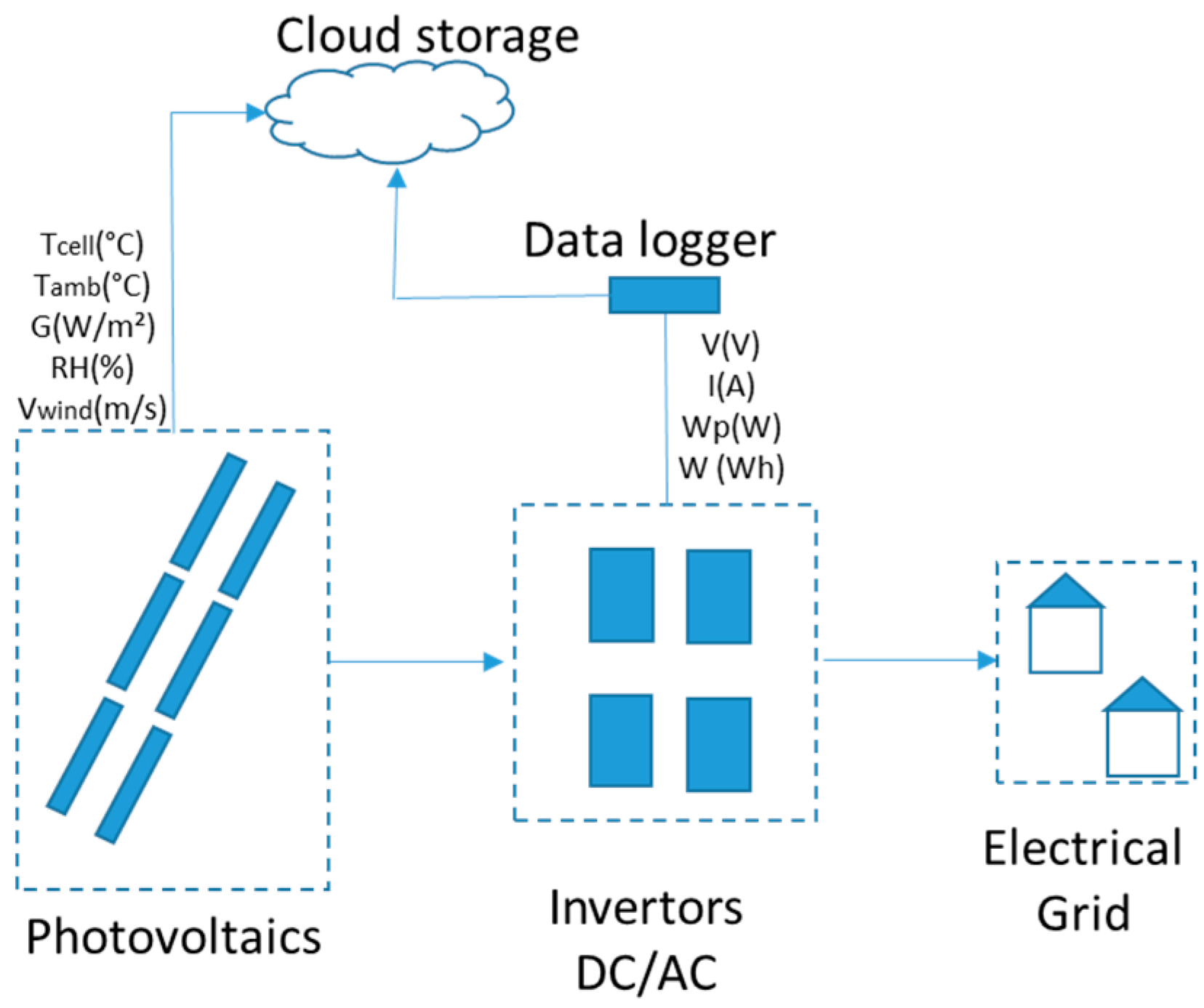
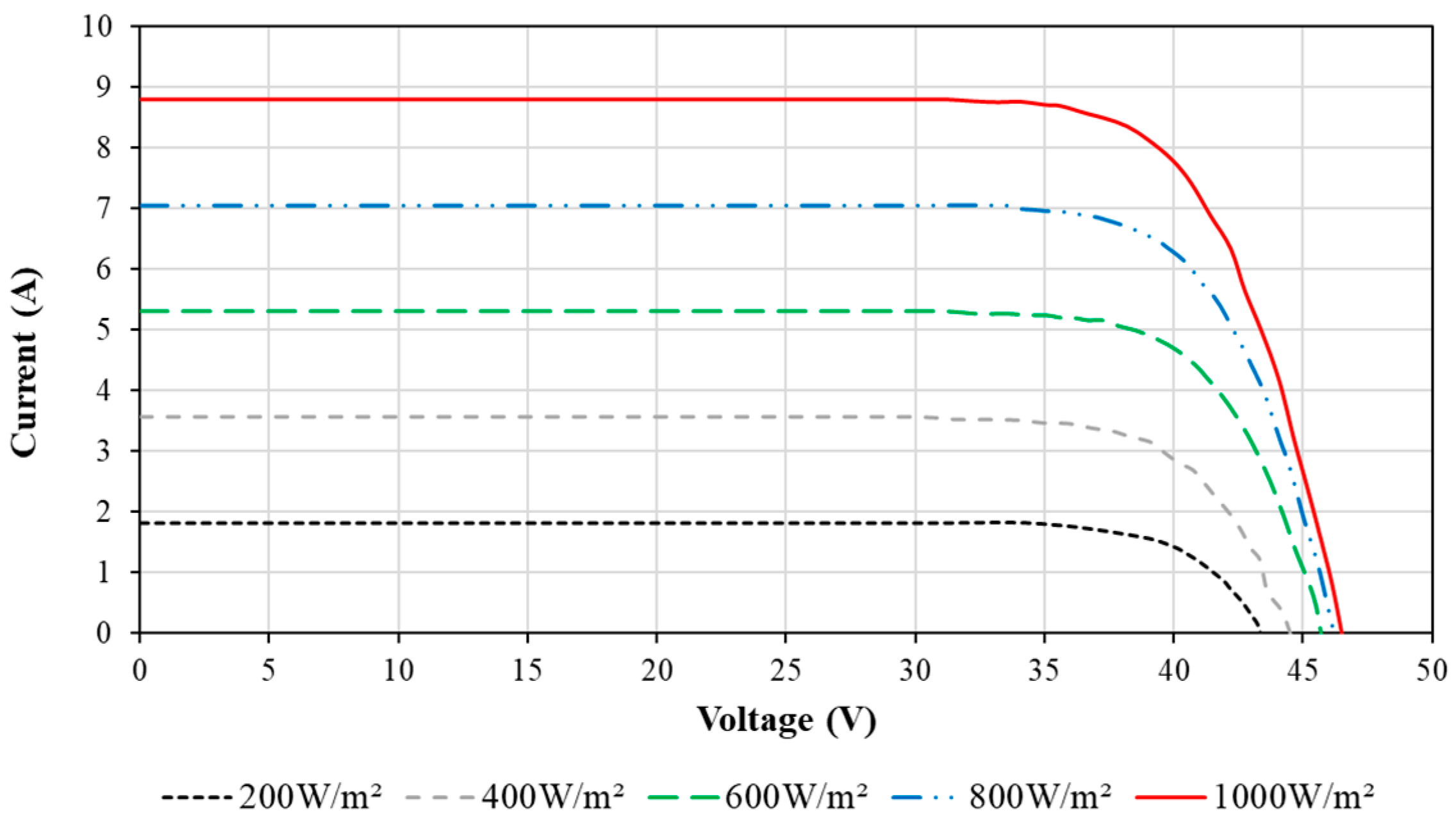

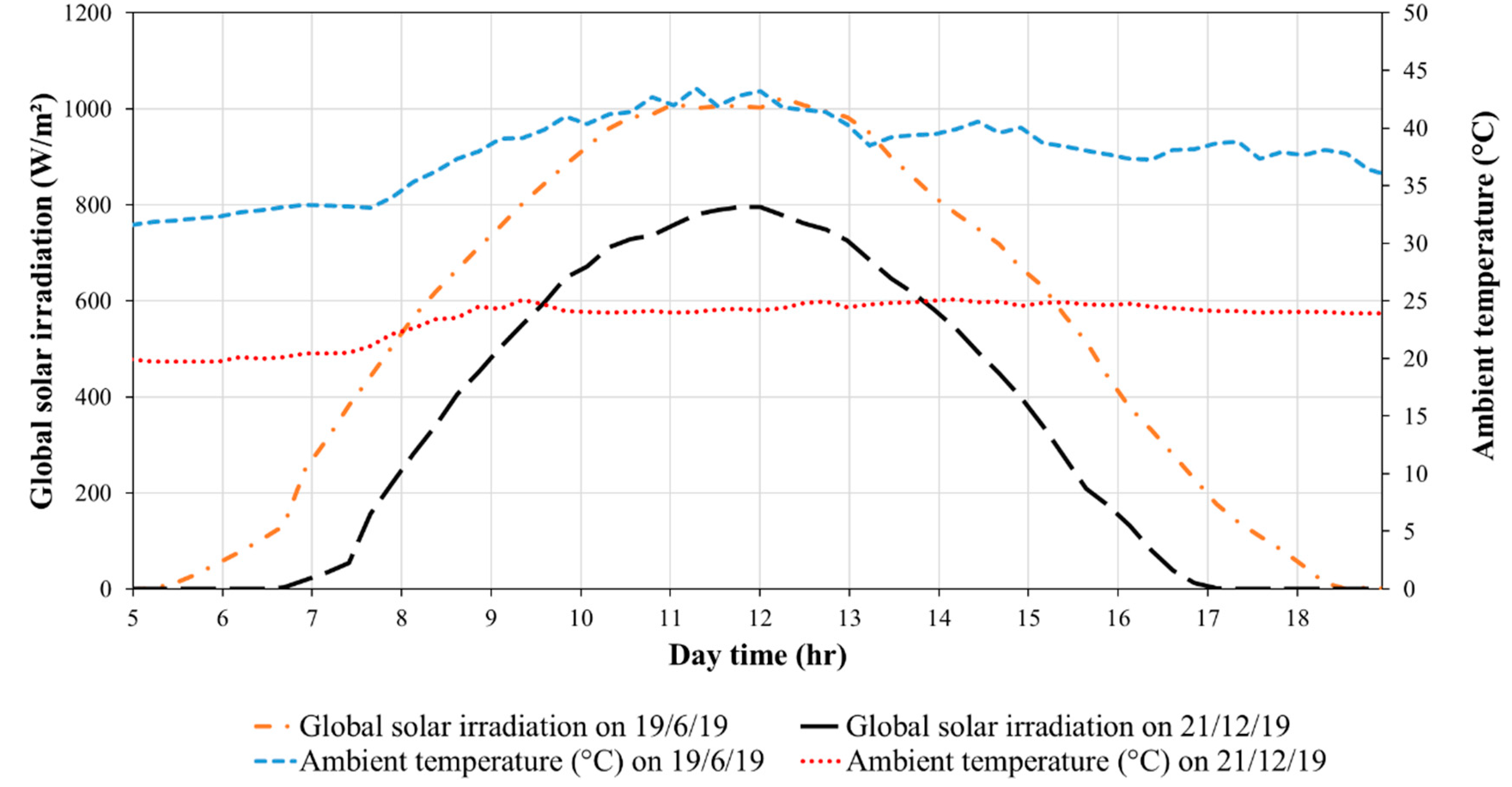
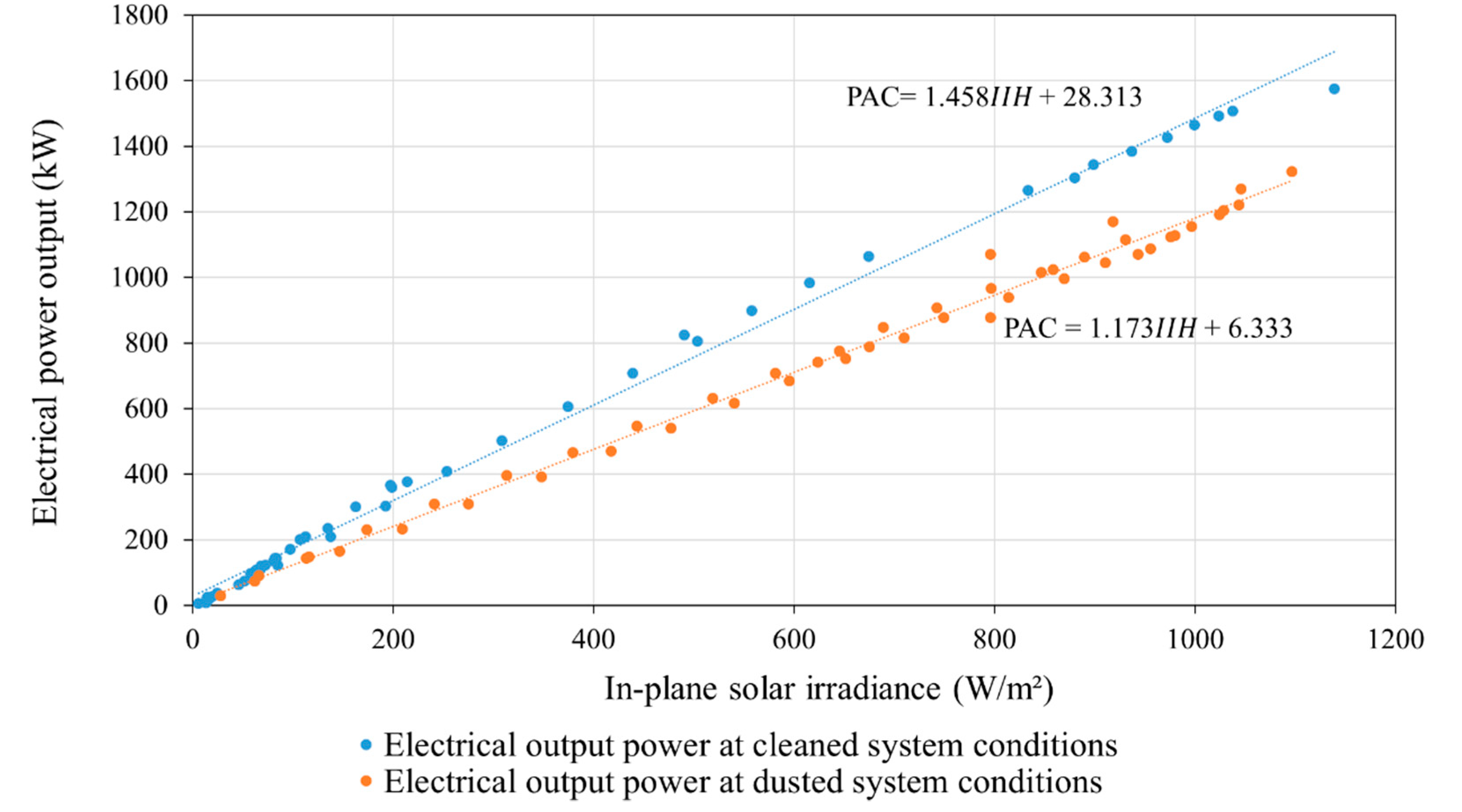
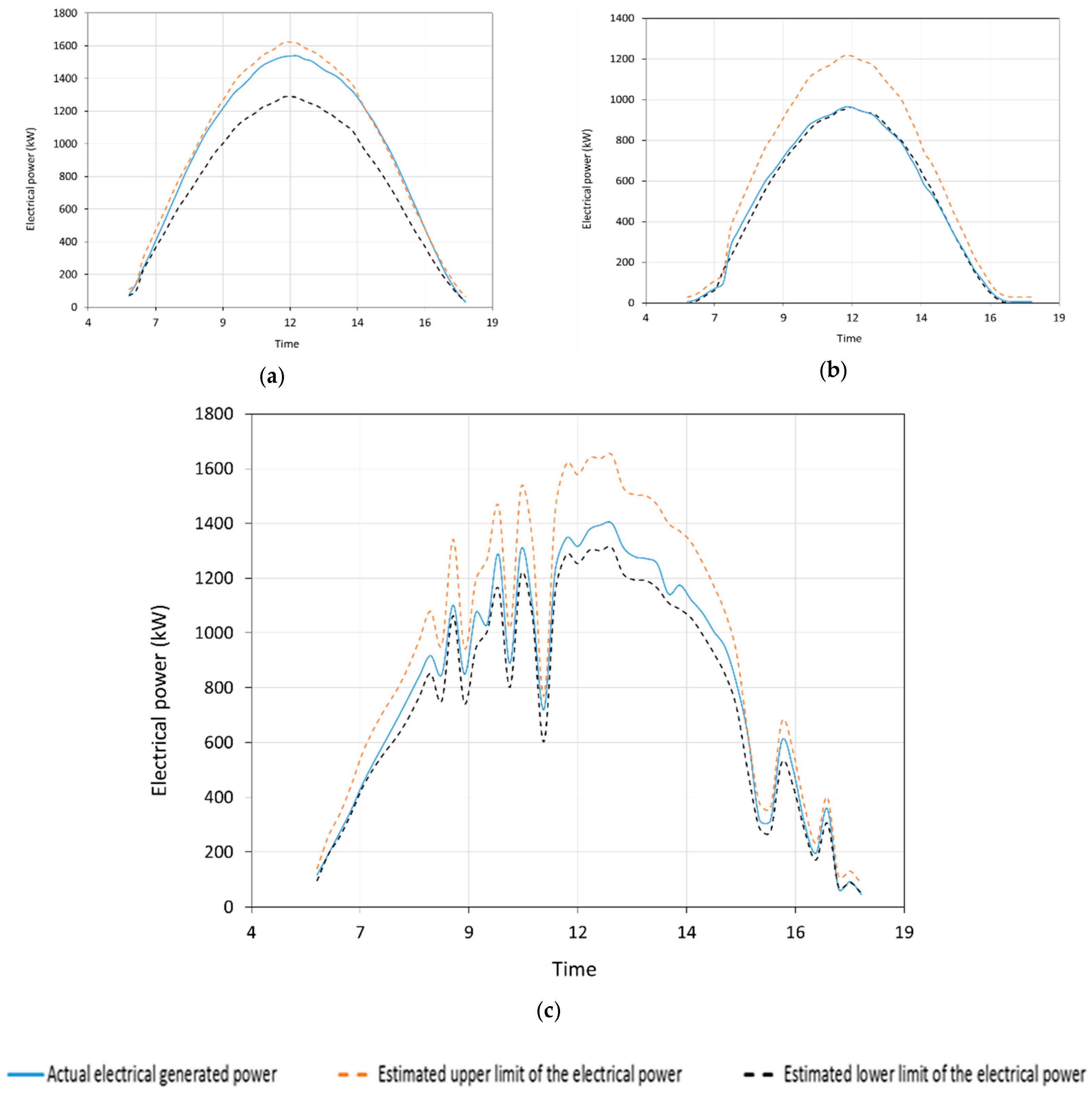
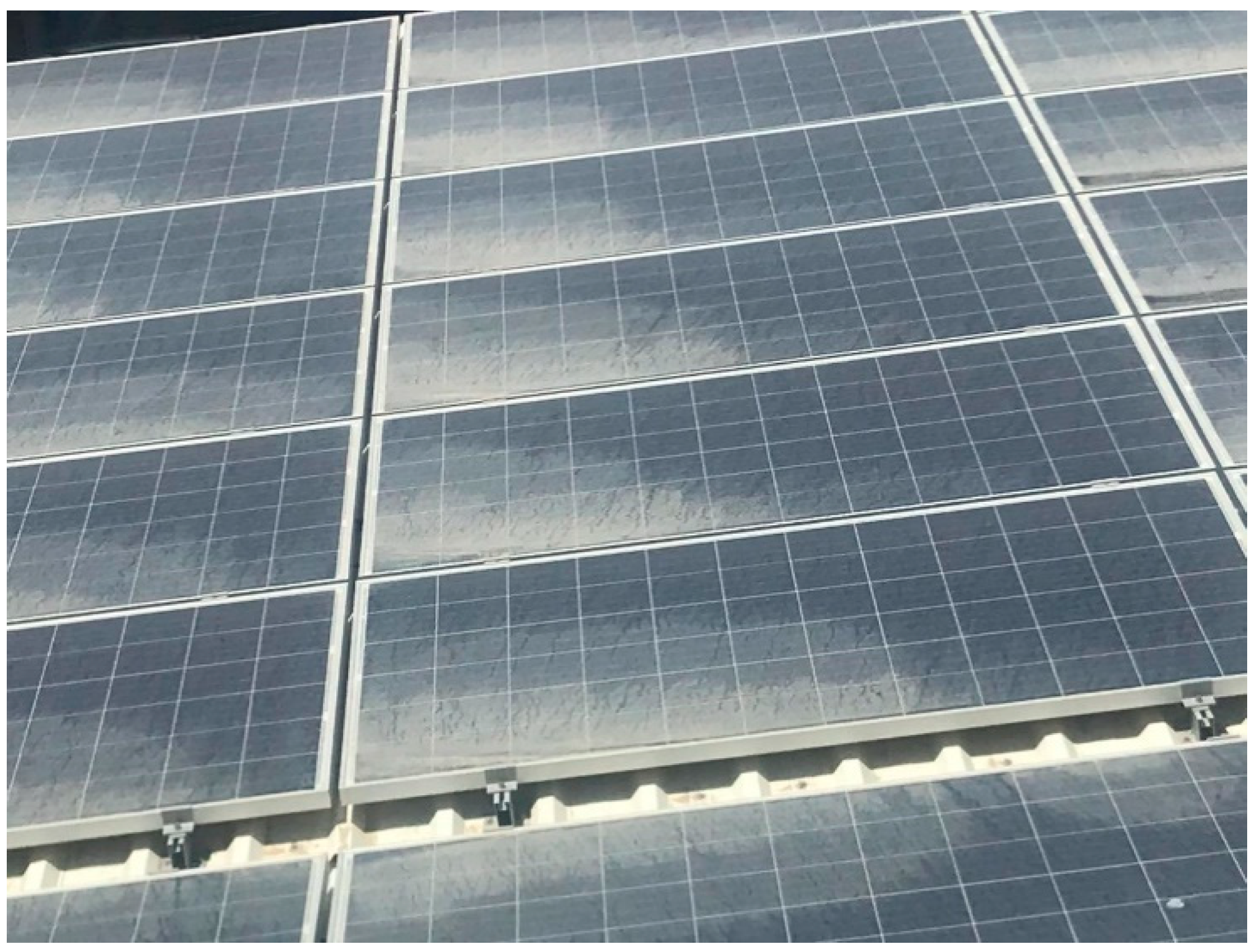


| Specification | Value |
|---|---|
| Maximum power (Wp) | 320 |
| Cell type | Poly |
| Maximum power voltage (V) | 37.38 |
| Maximum power current (A) | 9.06 |
| Open circuit voltage, Voc (V) | 46.22 |
| Short circuit current, Isc (A) | 8.56 |
| Module efficiency (%) | 16.51 |
| Temperature coefficient of short circuit current (%/°C) | 0.058 |
| Temperature coefficient of open circuit voltage (%/°C) | −0.330 |
| Temperature coefficient of maximum power (%/°C) | −0.410 |
| Number of cells | 72 |
| Module area (m2) | 1.938 |
| Specification | Value |
|---|---|
| Maximum efficiency (%) | 98.8 |
| DC input data | |
| Maximum Direct current (DC) power (W) | 90,000 |
| Maximum DC voltage (V) | 1000 |
| Alternate current (AC) output data | |
| Maximum AC power (W) | 60,000 |
| AC voltage range (V) | 360 to 530 |
| Item | Manufacturer | Model | Accuracy |
|---|---|---|---|
| Calibrated cell | Atersa | - | ±2% |
| Pyranometer | Geonica | GEO-SR20 | ±5 W/m2 |
| Ambient temperature sensor | Geonica | STH-S331 | ±0.1 °C |
| Relative humidity sensor | Geonica | STH-S331 | ±0.8% RH |
| Wind speed sensor | Geonica | 03002 | ±0.5 m/s |
| Wind direction sensor | Geonica | 03002 | ±5° |
| Logging System | Parameter |
|---|---|
| Weather station |
|
| Solar system |
|
| Global Solar Irradiance (W/m2) | Maximum Power Generation (kW) | |||||
|---|---|---|---|---|---|---|
| 15 April 2019 | 1 Week 21 April 2019 | 2 Weeks 28 April 2019 | 3 Weeks 5 May 2019 | 4 Weeks 12 May 2019 | 5 Weeks 19 May 2019 | |
| 1000 | 1460 | 1390 | 1405 | 1196 | 1155 | 904 |
| 800 | 1227 | 1148 | 1150 | 967 | 1071 | 918 |
| 600 | 935 | 870 | 861 | 725 | 684 | 669 |
| 400 | 642 | 599 | 630 | 408 | 470 | 465 |
| 200 | 329 | 306 | 353 | 248 | 234 | 235 |
| Global Solar Irradiance (W/m2) | Maximum Power Generation (kW) | |||||
|---|---|---|---|---|---|---|
| 15 April 2019 | 0.5 Month 1 May 2019 | 1 Month 15 May 2019 | 1.5 Month 1 June 2019 | 2 Months 15 June 2019 | 2.5 Months 1 July 2019 | |
| 1000 | 1460 | 1363 | 1181 | 1177 | 1148 | 1008 |
| 800 | 1227 | 1136 | 935 | 988 | 922 | 806 |
| 600 | 935 | 886 | 699 | 755 | 626 | 553 |
| 400 | 642 | 406 | 498 | 514 | 476 | 346 |
| 200 | 329 | 333 | 235 | 251 | 211 | 195 |
| Month | Monthly Electricity Generation (MWh) | ||||
|---|---|---|---|---|---|
| 0° | 5° | 10° | 15° | 23° | |
| May 19 | 286.29 | 283.10 | 284.28 | 280.53 | 270.62 |
| June 19 | 273.71 | 270.69 | 271.60 | 267.77 | 258.15 |
| July 19 | 267.90 | 265.15 | 266.29 | 262.69 | 253.15 |
| August 19 | 283.17 | 280.09 | 281.33 | 277.41 | 266.48 |
| September 19 | 271.77 | 268.87 | 270.28 | 266.38 | 254.33 |
| October 19 | 244.79 | 241.88 | 243.28 | 239.25 | 225.97 |
| November 19 | 201.51 | 198.99 | 200.11 | 196.48 | 184.06 |
| December 19 | 173.47 | 171.19 | 172.11 | 169.06 | 158.11 |
| January 20 | 195.26 | 192.81 | 193.94 | 190.61 | 178.52 |
| February 20 | 186.33 | 184.33 | 185.50 | 182.53 | 172.52 |
| March 20 | 274.18 | 271.21 | 272.69 | 268.51 | 255.26 |
| April 20 | 259.02 | 256.36 | 257.71 | 254.29 | 244.18 |
Publisher’s Note: MDPI stays neutral with regard to jurisdictional claims in published maps and institutional affiliations. |
© 2021 by the authors. Licensee MDPI, Basel, Switzerland. This article is an open access article distributed under the terms and conditions of the Creative Commons Attribution (CC BY) license (http://creativecommons.org/licenses/by/4.0/).
Share and Cite
Al Siyabi, I.; Al Mayasi, A.; Al Shukaili, A.; Khanna, S. Effect of Soiling on Solar Photovoltaic Performance under Desert Climatic Conditions. Energies 2021, 14, 659. https://doi.org/10.3390/en14030659
Al Siyabi I, Al Mayasi A, Al Shukaili A, Khanna S. Effect of Soiling on Solar Photovoltaic Performance under Desert Climatic Conditions. Energies. 2021; 14(3):659. https://doi.org/10.3390/en14030659
Chicago/Turabian StyleAl Siyabi, Idris, Arwa Al Mayasi, Aiman Al Shukaili, and Sourav Khanna. 2021. "Effect of Soiling on Solar Photovoltaic Performance under Desert Climatic Conditions" Energies 14, no. 3: 659. https://doi.org/10.3390/en14030659
APA StyleAl Siyabi, I., Al Mayasi, A., Al Shukaili, A., & Khanna, S. (2021). Effect of Soiling on Solar Photovoltaic Performance under Desert Climatic Conditions. Energies, 14(3), 659. https://doi.org/10.3390/en14030659







